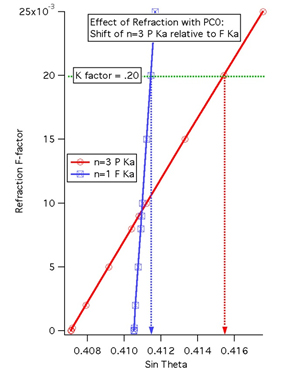I might try to get some value on our vintage JEOL-8600 with LDEC, LDEB and LDE1 crystals, but meanwhile, here are some values I randomly found on the web or in the literature (not even sure if I can find back the exact source of the data...):
Crystal (2d) = Refractive index "k"
PC0 (45 Å) = 0.006
LDE45 (45 Å) = 0.01
PC1 (60.6 Å) = 0.00832
LDE1 (60 Å) = 0.01
LDE1H (62.5 Å) = 0.008
PC2 (95 Å) = 0.021
LDE2 (98 Å) = 0.01
ODPb (100.7 Å) = 0.0175
PC25 (147.66 Å) = 0.02
LDEB (145 Å) = 0.01
PC3 (200.5 Å) = 0.02
LDE3 (200 Å) = 0.02
LDEC (200 Å) = 0.04
Hi Julien
This is useful. Let the testing begin!
By the way, I checked John Fournelle's early calculations and I'm confused. Did the graph labels for F ka and P ka III get swapped or did I screw up the calculation...?
The point is, John Fournelle made this graph some some time ago, and he showed that depending on the value of the PC0 refractive index, the P Ka 3rd order line will show up on one side *or* the other side of the F Ka line (and hence the corresponding spectral interference position!). But the F ka line in my calculation shows the larger change compared to P ka 3rd order for different refractive index values.

Anyway, is the refractive index of a PC0 (45 angstrom 2d) really 0.02? According to John F.'s measurements, the answer is yes.
Here is the calculation from the new CalcZAF window:
Spectro position for f ka on PC0 (160 mm), is 41542 (with refractive index correction, k= 0.02)
Spectro position for p ka (III) on PC0 (160 mm), is 41145 (with refractive index correction, k= 0.02)
The point is that with a large enough refractive index (0.02), the P Ka 3rd order line will shift relative to the F Ka 1st order line, enough to fall on the other side of the F Ka position! E.g.,
Spectro position for f ka on PC0 (160 mm), is
41542 (with refractive index correction, k= 0.02)
Spectro position for p ka (III) on PC0 (160 mm), is
41145 (with refractive index correction, k= 0.02)
Spectro position for f ka on PC0 (160 mm), is
41122 (with refractive index correction, k= 0.01)
Spectro position for p ka (III) on PC0 (160 mm), is
41099 (with refractive index correction, k= 0.01)
Spectro position for f ka on PC0 (160 mm), is
40711 (with refractive index correction, k= 0)
Spectro position for p ka (III) on PC0 (160 mm), is
41053 (with refractive index correction, k= 0)
A little help please!
Edit by John: Ok, as Julien has confirmed in the next post, John Fournelle's plot labels in the graph above are reversed.